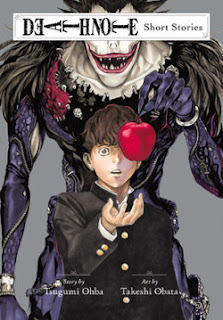Death Note: Short Stories is an anthology of short works set in the Death Note world that were originally published separately.
It has been a very long time since I last read or even watched any of the Death Note series. For the most part, this wasn't a problem, but I'd advise anyone who hasn't read the original series at all to steer clear of this volume because it includes major spoilers.
"C-Kira":
The police know that the original Kira is definitely dead, so when a new Kira pops up and starts killing people over the age of 65, they know that the media's speculation that he's back is wrong. However, someone clearly has a Death Note, and the police hope that Near (aka L's replacement) will help them find and stop that person.
This is, I think, our first real glimpse of the Death Note world after everything went down. From the sounds of things, although Light isn't around anymore, his influence has persisted and the world is magically more peaceful. (Because killing people definitely stops war and crime.)
This particular story is tied to the ethics of euthanasia in a country with a growing percentage of elderly people, but it doesn't dig into the issue too deeply. It's resolved in a way that felt too neat and easy. It probably didn't help my overall opinion of the story that I'm firmly in the "Near will always be the lesser L" camp.
"a-Kira":
This takes place after the previous story. Ryuk sees to it that a boy named Minoru Tanaka gets a Death Note, figuring that a kid like him, who's done well on tests like Light, will last longer than the previous new Kira and provide him with more opportunities to eat apples. However, the world is different from when Light had the Death Note, and the tricks he used wouldn't work for Minoru. Plus, Minoru isn't actually interested in killing anyone...so he comes up with another plan.
This was reasonably clever. I winced a bit at the inclusion of a certain US president (no name, but he was definitely recognizable), although Ohba presenting him as a man who wouldn't sacrifice himself for his country but would absolutely lie to get praise from others was amusing. The setup was there to just kill him off, but I doubt Jump Square wanted that kind of attention.
If I remember right, there was some Death Note rule-changing in the original series, so the rule change in this story didn't bother me much. It made sense that, one way or another, the Shinigami would always win.
I'm still not a fan of Near.
Death Note four-panel comics:
Lukewarm feelings. None of these made me laugh.
"L - One Day":
It's a day in L's life. Find out how he sleeps, uses the toilet, washes himself, gets dressed, and entertains himself.
This takes all the L jokes so far that it's tough to believe he ever managed to play a serious game of tennis against Light.
"L - Wammy's House":
A few pages showing what L was like when he first came to Wammy's House and the period leading up to his reputation as a gifted detective. He was a creepy, creepy child.
"Taro Kagami":
A thirteen-year-old kid named Taro Kagami finds a Death Note and, not being able to read the rules written inside it (in English), uses it as a journal to write about his day. Specifically, he writes about the kids who bullied him. The next day he learns they all died of heart attacks. He gradually realizes what his notebook is capable of and then meets Ryuk. However, he's not the only kid around with a Death Note.
I didn't realize this until I started working on this review, but this was actually the Death Note manga pilot. A brief explanation of this prior to the story would have been very helpful. I was so confused, trying to figure out where and how this fit into the series timeline. Plus, it introduced a mechanic that never came up in the series, a Death Note eraser.
Now that I know this was a pilot, the ending bugs me a lot less.
All in all, this was an okay volume for fans of the original series, but not essential reading unless, for some reason, you want to see more of Near in action (although "Near inaction" is probably more accurate).
Extras:
A couple full-color illustrations.

No comments:
Post a Comment